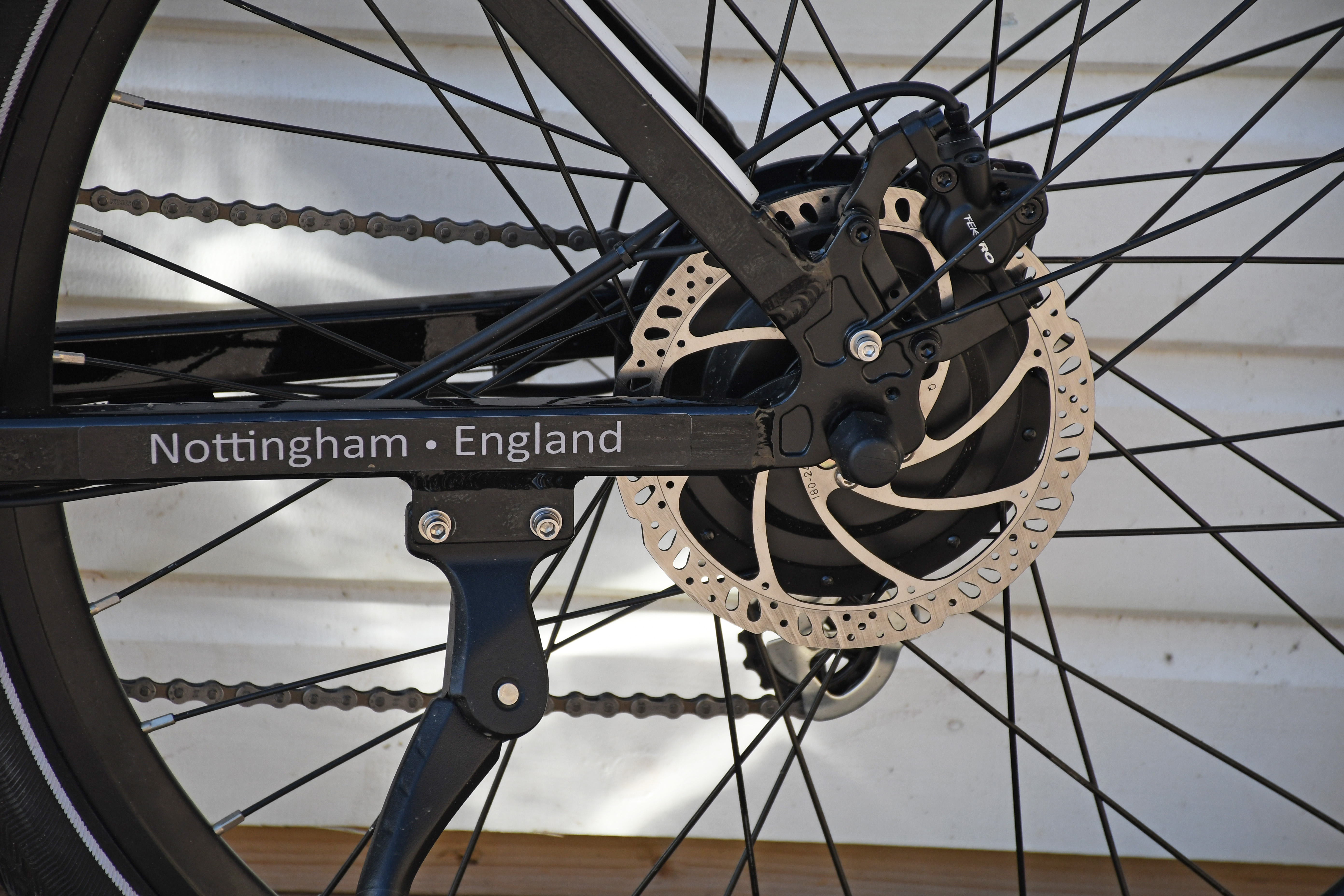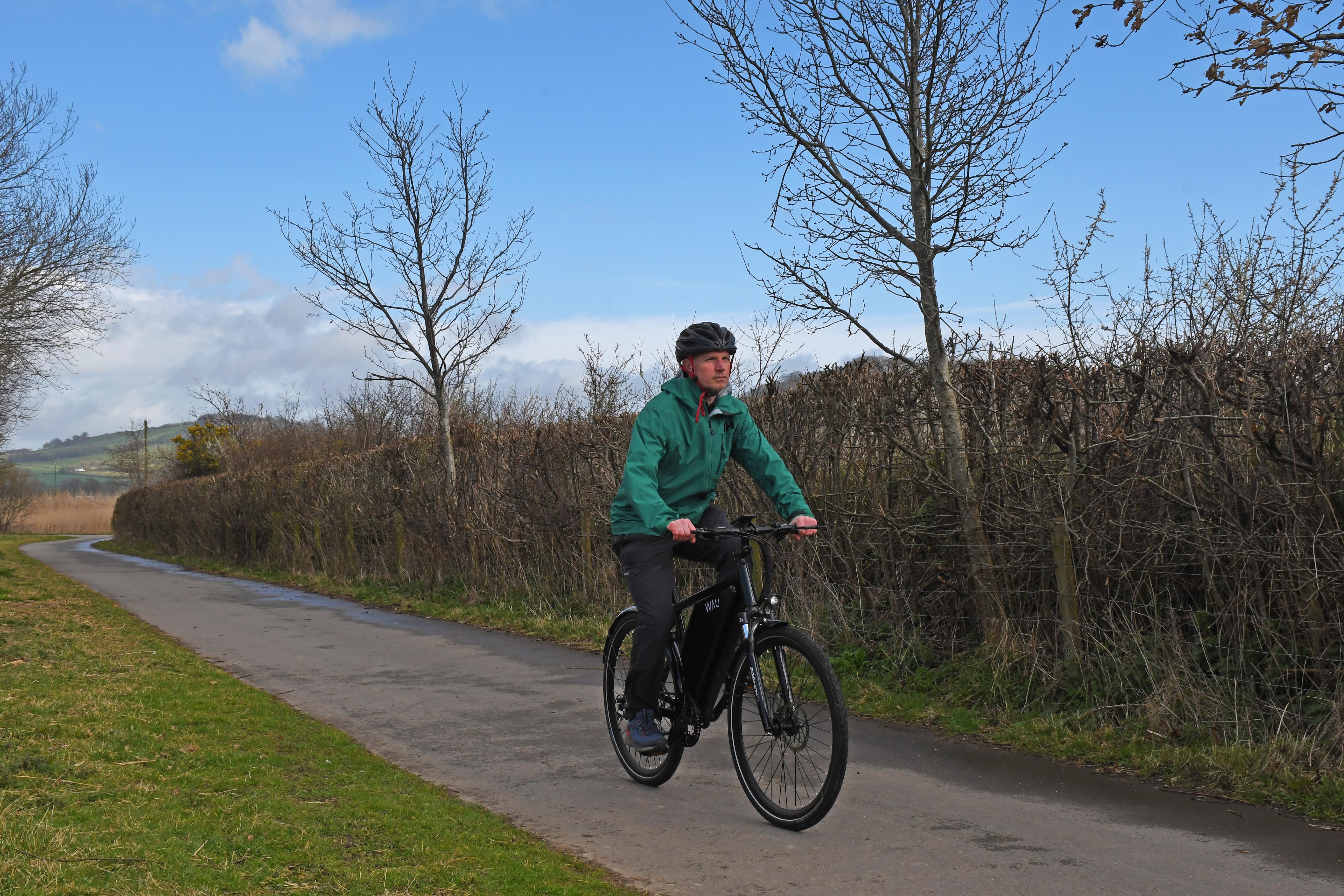WAU X Plus review: brilliant e-bike with big riding range and funky features
Fully charged, the charismatic WAU X Plus e-bike will give you up to 100 miles of power-assisted riding


With a massive power-assisted riding range of up to 100 miles (in the more expensive touring model), a very reasonable price tag, and a whole collection of innovative features combined with good-quality componentry, the WAU X Plus is an exciting and eccentric e-bike that will suit riders looking for a city slicker that’s capable of facilitating adventures much further afield at the weekend.
-
+
Massive range
-
+
Integrated display and lights
-
+
Locking system and alarm
-
+
Lots of funky features
-
+
Locally made, with love
-
+
Good price
-
-
Heavy and too bulky for many touring riders
-
-
One-size frame won’t work for everyone
-
-
No lock-out on front forks
Why you can trust T3

WAU X Plus review in a sentence: With a big battery, it’s an awkwardly heavy machine to manoeuvre, and some of the funkier features lean more towards the fancy than the functional, but the WAU is a fun and stylish steed to cruise around on.
WAU is an acronym for We Are Underdogs and this vibe seems genuinely reflective of the background and structure of this start-up British brand, which began with two friends sitting around a table sketching a dream bike and mapping out a vision. From there it grew organically into what it is now: a small but committed design and production team of highly invested individuals. It’s about as far removed from the behemoth brands of the bicycling world, such as Specialized, as it’s possible to be.
But did that session at the kitchen table lead to the creation of a machine worthy of inclusion in our line-up of the best e-bikes available today? The WAU X Plus is certainly different to other offerings, so I took this unique steed out for several extended spins to see how it performs. Read on to see how I rated it.
(First reviewed April 2023)
WAU X Plus review: What is it?
Inspiration for the WAU X Plus seems to have sprung from a desire to create a super-efficient two-wheeled e-vehicle rather than from a deep-rooted connection to the cycling world, which partly explains why this machine looks more like a very stripped-back motorbike rather than an amped up pushbike.
But the WAU founders have evidently fully engaged with the riding community to refine the design over the years. Now in its fifth iteration, the e-bike this brand has lovingly created oozes character and individualism. Designed in Nottingham and made in Essex, the WAU crew have evidently poured plenty of personality, enormous amounts of energy and a saddlebag-load of original ideas into this bike, and the result is a hybrid machine that sits somewhere between a cool commuter and leggy tourer.
Indeed there are two options, which direct potential purchasers in one direction or the other, but the only real difference between the ‘Commuter’ and the ‘Tourer’ models is the battery capacity, with the 900Wh-rated Tourer offering up to 100 miles of power-assisted pedalling on a single charge (while the 378Wh-rated Commuter can do up to 40 miles). I tested out a WAU X Plus Tourer, and this review is based on that model.
Get all the latest news, reviews, deals and buying guides on gorgeous tech, home and active products from the T3 experts
WAU X Plus review: Specifications
- Weight: 23kg (Commuter) / 27kg (Tourer)
- Range: 40 miles (Commuter) / Up to 100 miles (Tourer)
- Charging time: 12 hours (slow charger) / 6 hours (Supercharger)
- Gears: 8
- Battery assist levels: 5
- Power: 250W / 36V / 378Wh (Commuter) or 900Wh (Tourer)
- Wheel size: 29”
WAU X Plus review: price and availability
Available to purchase now, the WAU X Plus comes in two main versions: the basic commuter model (RRP: £1,999) and the touring model (RRP: £2,499), which has a much bigger range, but is also considerably heavier. (It’s also possible to get Derestricted version of the WAU X Plus, which will let you travel at speeds of up to 20mph/32kmph on battery assisted power, and is available with a throttle for improved acceleration, but this rig can only be ridden on private roads and it’s not street legal in the UK, so is not the focus of this review.)
While the WAU X Plus comes primed to ride, with everything you need to get it juiced up and ready to roll, there are various upgrades you can select at the point of purchase that will improve the riding experience. It’s sold with a black-and-white display screen, but you can upgrade to a Smart Colour LCD screen for an additional £159 (my test model came with the colour version installed). It’s also possible to swap the ‘Slow Charger’ (12 hours per full charge) for a Supercharger (£139), which will halve that charge time. Additional upgrades include a comfier saddle, mudguards, a rear carrying rack and pannier bag.

WAU X Plus review: motor and battery power
The WAU X Plus bike is fitted with a Bafang Performance Line motor system powered by an 882Wh/900Wh Samsung battery, which can be removed for charging. The tourer is a 250W bike (which is at the top of the legal limit in the UK), but the battery capacity of 900Wh (which stands for ‘Wattage Hours’ and relates to the amount of Watts that can be delivered from the battery to the motor each hour) is big. For context, most e-bikes offer between 300Wh and 500Wh.
The brand claim that the tourer version of the WAU X Plus has the longest range of any e-bike currently available. In a very fast-moving market with myriad models and styles emerging all the time, I think this is possibly up for debate, but suffice to say, the WAU X Plus definitely has plenty of guts and can do very impressive distances. On a single charge, the tourer can keep providing power assistance for up to 100 miles (depending on the settings used and the terrain and landscape covered, of course), while the much lighter commuter model can do around 40 miles (again, depending on several variables).

The drive chain features a single cog on the front, with Shimano 8 Speed Acera cassette on the rear. A rear-wheel drive, the e-system is activated by a cadence sensor, so – as with all e-bikes – you need to put in some pedalling action before the motor will kick in and start helping. There are 5 levels of assistance to choose from (including a walk mode for assistance when pushing the bike), which are easy to toggle through via the + and - buttons on the handlebar-mounted control panel. The number engaged at any given moment is clearly displayed on the LCD screen. Power from the motor will cut out once you go past 15.5mph (25km/ph), which is a legal requirement for e-bikes in the UK.
The WAU X Plus bike frame is designed around a one-size-can-fit-all principle, and WAU say it’s suitable for riders between 165cm and 193cm in height. With 29” wheels, the frame has a stand-over height of 79cm. The geometry of the frame is very relaxed, and you ride it in a fairly upright and comfortable position, as befits a bike intended for commuting and touring.
The bike comes with a Shimano cassette and gear shifters, Tektro hydraulic disc brakes, Schwalbe tyres and a Suntour XCT30-DS front fork with 100mm of travel. The battery – which is huge and heavy on the tourer – is housed in a large compartment located on the frame, which also contains the smart computer, GPS and locking system. To open this compartment you need two keys, which also allow you to activate an alarm, which starts shrieking if someone moves the bike while it is locked.

The easy-to-use control panel is located on the left of the handlebars, and this is where you will find the on/off button, indicator controls and the plus and minus buttons for selecting the level of power assistance required. The power level, plus a range of information including your speed and trip distance is displayed on the centrally mounted LCD screen. The front light, which now comes pre-installed on the bike, is activated from the control panel.
The rear and side lights come on as soon as you activate the bike. The side lights take the form of large WAU logos on the oversized battery compartment, and back-light illumination comes via two strip lights integrated into the stems of the frame’s rear fork. These twin rear lights also operate as indicators, with either the left or right light flashing from red to white when the corresponding directional arrow is clicked on the control panel.

WAU X Plus review: Riding performance
The first thing to say about this bike is that it’s very heavy. The weight given in the official specs for the touring model is 27kg, with the big-arse battery accounting for a good 5kg of that. However, with all the bells and whistles, it’s more like 29kg, and the WAU feels all of that when you’re manoeuvring it around. You’re not going to be hanging this bike up in the garage, and if you live in a flat, and can’t keep your bikes on ground level, this is definitely not the steed for you.
All that said, once I was in the saddle, I really enjoyed riding this bike around in an urban environment. I live at the top of a huge hill in a very lumpy Devon town where you can’t travel more than 100 metres without encountering some serious elevation, so it was great to have the extra oompf this steed provides while I was cycling around the place on general day-to-day business. But, of course, this bike was designed for much more than this.
I took the WAU X Plus on several longer trips – I didn’t quite push it to 100 miles on any single outing, but well past the 50-mile mark on one foray into the rollercoaster terrain of the Blackdown Hills, which rise between Devon and Somerset, the display screen was telling me the battery was still between a half and two-thirds full, so I have confidence in the claim that you can get 100 miles from a single charge.
It did take me some time to get used to the best way of riding a bike like this. Initially, I kept gunning it and wondering – like an idiot – why I couldn’t feel any extra benefit when I amped up the power level from 2 all the way through to 5. Rapidly I realised that as soon as I went over 15.5mph I wasn’t getting any extra assistance at all, because the motor stops helping at that speed.

This isn’t the fault of the WAU X Plus, it’s a legal requirement in the UK, but after hitting that cut-off you are simply attempting to pedal a very heavy bike up a hill. The best approach is to slow down a bit and drop a couple of gears to increase your cadence until the motor kicks in, and then you can comfortably trundle up most ascents at a reasonable rate of knots. Unless you want a serious work-out, of course, in which case you can keep thrashing yourself and save the battery juice for when you run out of puff – but this isn’t a bike designed for fitness-orientated cyclists.
Mostly I rode the WAU X Plus on sealed roads and hard-packed tracks, but since it has a MTB frame and features a front fork with suspension and 100mm of travel, I did take it off-road for a few spins. The weight and spec don’t lend themselves to technical off-road riding – such a heavy bike doesn’t have the necessary nimbleness or handling capacity to make for an enjoyable spin over tight trails or anything too lumpy and bumpy. However, on forestry and gravel tracks, unmetalled roads and less technical trails it’s absolutely fine, and the 29” wheels combined with the front suspension enable it to roll over the occasional low-level obstruction.
WAU X Plus review: Features and functions
The fact that this bike now comes with its own front and rear lights, which do their job more than adequately and feed straight off the main battery, makes it even more of a bargain than it already was.
The indicator lights on the rear fork are pretty funky, but I definitely wasn’t comfortable relying on drivers seeing them while riding on the road – especially during bright daylight hours, when the flashing is pretty hard to discern – so I found myself using my arms to signal left and right turns as normal. Also, the indicators don’t auto cancel, and it’s very easy to forget and leave them on. Still, they’re a nice feature and work well on urban roads at night.

The 100mm travel in the front forks is good for eliminating wrist stress, especially on corrugated trails, but it would be good if the suspension could be locked out for improved efficiency and performance on the road.
The locking and alarm system is good, although it’s a pain having to carry two keys around, when one would surely suffice. I like the fact that you can take the battery out to charge it, and the range of the bike is very impressive, but the weight of the battery – and therefore the bike – make it very cumbersome. If you were to run out of juice, it would be a very long, slow ride home.
The integrated control panel and display screen are great. For an outlay of about £10 per year you can link the WAU X bike to an app that facilitates mapping, GPS tracking and security features, and provides access to bike data including real-time location tracking and virtual security.

WAU X Plus review: verdict
I really love the ethos and the energy behind this brand and the bike they have produced, but if I’m honest, I wanted to like the WAU X Plus more, and I actually enjoyed riding it in many scenarios. The range is really impressive, but the weight of the large battery is a big price to pay for it.
It wouldn’t be my model of choice for regular touring, but cycling is a very subjective experience, and it will suit other people who want to enjoy relaxed days, cruising around country roads and lanes at 15mph and taking on some longer outings, safe in the knowledge that they can get reliable power assistance on the hills and a bit of extra help on the way home if they want it.
Likewise, many riders will enjoy booting around city roads and suburban streets on the WAU X Plus, where its many funky features come into their own. If this is your preferred cycling environment, I’d suggest saving yourself a few quid and a whole lot of weight and going for the commuter model.
Both the commuter and the tourer versions of the WAU X Plus are full of charisma, however, and this is a very affordable machine compared to virtually every other e-bike on the market – certainly those with anywhere near the range that this steed offers. It also feels like a unique bike that will continue to evolve in interesting directions, so I look forward to seeing what innovations the WAU crew come up with next.
WAU X Plus review: Also consider
Another affordable e-bike with plenty of character is the Honbike Uni4, which has an interesting and unique design; it’s more limited to mainly urban environments, however, and doesn’t offer the range of the WAU X Plus. Read Rob's Honbike Uni4 review.
If you’re looking for unfussy functionality and a low price point, the Pure Electric Pure Flux One bike is available for under grand and does everything most people want from a commuter-style e-bike, but it only has a range of 5 miles. Read Duncan's Pure Electric Pure Flux One review.
Several times more expensive, the Volt Infinity is a more versatile and high-specced steed that offers a range of up to 90 miles - although it’s not as geared up for touring as the WAU X Plus. Read the full Volt Infinity review, also from Rob.
You’ll need to splash some cash to own BMC’s AMP AL TWO, but that money will buy you a beautifully made, powerful and comfortable all-rounder of an e-bike that’s equally happy on the daily commute and on touring routes. Read Sian's full BMC AMP AL TWO review.

Author of Caving, Canyoning, Coasteering…, a recently released book about all kinds of outdoor adventures around Britain, Pat Kinsella has been writing about outdoor pursuits and adventure sports for two decades. In pursuit of stories he’s canoed Canada’s Yukon River, climbed Mont Blanc and Kilimanjaro, skied and mountain biked across the Norwegian Alps, run ultras across the roof of Mauritius and through the hills of the Himalayas, and set short-lived speed records for trail-running Australia’s highest peaks and New Zealand’s nine Great Walks. A former editor of several Australian magazines he’s a longtime contributor to publications including Sidetracked, Outdoor, National Geographic Traveller, Trail Running, The Great Outdoors, Outdoor Fitness and Adventure Travel, and a regular writer for Lonely Planet (for whom he compiled, edited and co-wrote the Atlas of Adventure, a guide to outdoor pursuits around the globe). He’s authored guides to exploring the coastline and countryside of Devon and Dorset, and recently wrote a book about pub walks. Follow Pat's adventures on Strava and instagram.